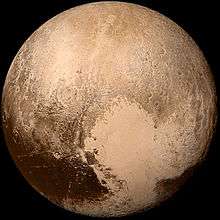(307261) 2002 MS4
| Discovery[1] | |
|---|---|
| Discovered by |
Chad Trujillo, Michael E. Brown |
| Discovery date | 18 June 2002 |
| Designations | |
| MPC designation | 2002 MS4 |
| none | |
|
Cubewano (MPC)[2] ScatExt (DES)[3] | |
| Orbital characteristics[4] | |
| Epoch 13 January 2016 (JD 2457400.5) | |
| Uncertainty parameter 3 | |
| Observation arc | 20569 days (56.31 yr) |
| Aphelion | 47.740 AU (7.1418 Tm) |
| Perihelion | 35.694 AU (5.3397 Tm) |
| 41.717 AU (6.2408 Tm) | |
| Eccentricity | 0.14439 |
| 269.45 yr (98415.8 d) | |
Average orbital speed | 4.58 km/s |
| 216.187° | |
| 0° 0m 13.168s / day | |
| Inclination | 17.677° |
| 215.963° | |
| 215.534° | |
| Earth MOID | 34.7228 AU (5.19446 Tm) |
| Jupiter MOID | 30.7148 AU (4.59487 Tm) |
| Jupiter Tisserand parameter | 5.464 |
| Physical characteristics | |
| Dimensions | 934±47 km[5] |
|
0.051+0.036 −0.022 [5] | |
| Temperature | ≈ 43 K |
|
B−V=0.69; V−R=0.38 [6] | |
| 20.6[7] | |
|
3.7[4] 3.5±0.4 (R-band)[5] | |
|
| |
(307261) 2002 MS4 is a large classical Kuiper belt object,[2] the second-largest known object in the Solar System without a name, after 2007 OR10. It was discovered in 2002 by Chad Trujillo and Michael Brown.
Brown's website lists it as nearly certain to be a dwarf planet.[8] The Spitzer Space Telescope estimated it to have a diameter of 726±123 km.[9] The Herschel team estimates it to be 934±47 km, which would make it one of the 10 largest TNOs currently known[5] and large enough to be considered a dwarf planet under the 2006 draft proposal of the IAU.[10] It is currently 47.2 AU from the Sun[7] and will come to perihelion in 2123.[4]
It has been observed 55 times, with precovery images back to 1954.[4]
References
- ↑ "MPEC 2002-W27 : 2002 MS4, 2002 QX47, 2002 VR128". IAU Minor Planet Center. 2002-11-21. Retrieved 2009-08-26.
- 1 2 "MPEC 2009-P26 :Distant Minor Planets (2009 AUG. 17.0 TT)". IAU Minor Planet Center. 2009-08-07. Retrieved 2009-08-31.
- ↑ Marc W. Buie (2008-05-03). "Orbit Fit and Astrometric record for 02MS4". SwRI (Space Science Department). Archived from the original on 29 June 2011. Retrieved 2009-08-31.
- 1 2 3 4 "JPL Small-Body Database Browser: 307261 (2002 MS4)" (2009-09-19 last obs.). Jet Propulsion Laboratory. Retrieved 7 April 2016.
- 1 2 3 4 Vilenius, E.; Kiss, C.; Mommert, M.; et al. (2012). ""TNOs are Cool": A survey of the trans-Neptunian region VI. Herschel/PACS observations and thermal modeling of 19 classical Kuiper belt objects". Astronomy & Astrophysics. 541: A94. arXiv:1204.0697
 . Bibcode:2012A&A...541A..94V. doi:10.1051/0004-6361/201118743.
. Bibcode:2012A&A...541A..94V. doi:10.1051/0004-6361/201118743. - ↑ Tegler, Stephen C. (2006-01-26). "Kuiper Belt Object Magnitudes and Surface Colors". Archived from the original on November 16, 2007. Retrieved 2006-11-05.
- 1 2 "AstDyS 2002MS4 Ephemerides". Department of Mathematics, University of Pisa, Italy. Archived from the original on 2009-09-04. Retrieved 2009-08-27.
- ↑ Michael E. Brown. "How many dwarf planets are there in the outer solar system? (updates daily)". California Institute of Technology. Archived from the original on 2011-10-18. Retrieved 2011-08-25.
- ↑ Stansberry, Grundy, Brown, Spencer, Trilling, Cruikshank, Luc Margot Physical Properties of Kuiper Belt and Centaur Objects: Constraints from Spitzer Space Telescope (2007) Preprint arXiv
- ↑ O. Gingerich (2006). "The Path to Defining Planets" (PDF). Harvard-Smithsonian Center for Astrophysics and IAU EC Planet Definition Committee chair. Retrieved 2007-03-13.
External links
- Orbital simulation from JPL (Java) / Ephemeris
- 2002 MS4 Precovery Images
- (307261) 2002 MS4 at the JPL Small-Body Database
This article is issued from Wikipedia - version of the 9/8/2016. The text is available under the Creative Commons Attribution/Share Alike but additional terms may apply for the media files.
_(cropped).jpg)
